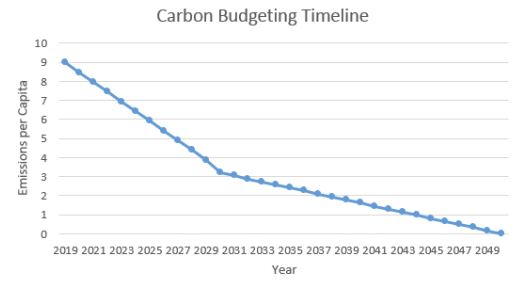greatest burden put upon those nations and cities with the greatest resources with which to address it.
The highly industrialized City of Windsor is classified as a high emissions, high GDP city and as such must reduce emissions drastically and rapidly to be in accordance with the global carbon budget.
Calculation of Carbon Budget
The IPCC outlines that high GDP, high emissions cities must converge on a per-capita emissions limit of 3.2 tonnes per year by the year 2030 and then decrease to zero emissions by 2050. Beyond 2050 no net emissions are permitted. The carbon budget for Windsor is calculated using these convergence points along with the current level of GHG emissions for Windsor, as presented to council in report $164/2019,
The baseline for calculating Windsor’s carbon budget is the current per-capita emissions level of 8.9 Tonnes per year (2018 inventory). There are two major milestones in the carbon budget approach, the 3.2 tonnes per capita by 2030 and net zero by 2050. By graphing these goals along with the current baseline, carbon budgets for the 2030 and 2050 goals can be calculated. The graph below displays a timeline for emissions reduction based on the IPCC C40 carbon budget protocol

Figure 1 — Allowable Carbon Emissions vs Time 2019 through 2050.
Using the calculated carbon budgets for 2030 and 2050 it can be determined in which year the allotted carbon budget will be exceeded for each milestone if per capita emissions remain at current levels while accounting for population growth. The table below presents the carbon budget for each milestone and the year that the carbon budget is used up.